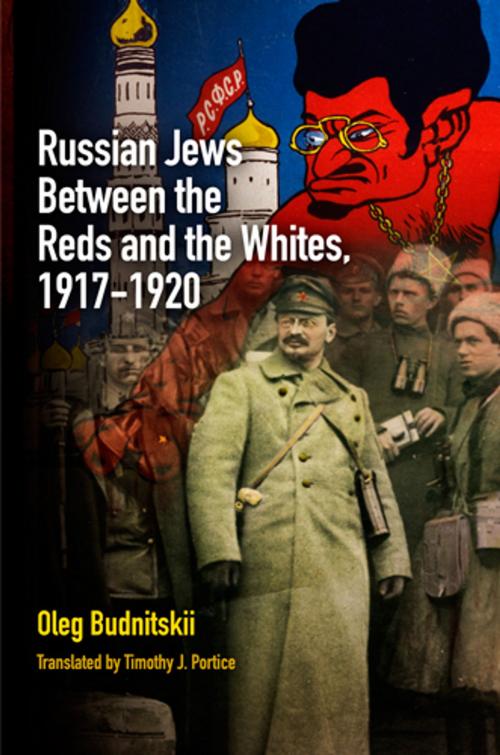Russian Jews Between the Reds and the Whites, 1917-1920
Nonfiction, Religion & Spirituality, Judaism, History, Asian, Russia, Social & Cultural Studies, Social Science| Author: | Oleg Budnitskii | ISBN: | 9780812208146 |
| Publisher: | University of Pennsylvania Press, Inc. | Publication: | July 24, 2012 |
| Imprint: | University of Pennsylvania Press | Language: | English |
| Author: | Oleg Budnitskii |
| ISBN: | 9780812208146 |
| Publisher: | University of Pennsylvania Press, Inc. |
| Publication: | July 24, 2012 |
| Imprint: | University of Pennsylvania Press |
| Language: | English |
In the years following the Russian Revolution, a bitter civil war was waged between the Bolsheviks, with their Red Army of Workers and Peasants on the one side, and the various groups that constituted the anti-Bolshevik movement on the other. The major anti-Bolshevik force was the White Army, whose leadership consisted of former officers of the Russian imperial army. In the received—and simplified—version of this history, those Jews who were drawn into the political and military conflict were overwhelmingly affiliated with the Reds, while from the start, the Whites orchestrated campaigns of anti-Jewish violence, leading to the deaths of thousands of Jews in pogroms in the Ukraine and elsewhere.
In Russian Jews Between the Reds and the Whites, 1917-1920, Oleg Budnitskii provides the first comprehensive historical account of the role of Jews in the Russian Civil War. According to Budnitskii, Jews were both victims and executioners, and while they were among the founders of the Soviet state, they also played an important role in the establishment of the anti-Bolshevik factions. He offers a far more nuanced picture of the policies of the White leadership toward the Jews than has been previously available, exploring such issues as the role of prominent Jewish politicians in the establishment of the White movement of southern Russia, the "Jewish Question" in the White ideology and its international aspects, and the attempts of the Russian Orthodox Church and White diplomacy to forestall the establishment of a Jewish state in Palestine.
The relationship between the Jews and the Reds was no less complicated. Nearly all of the Jewish political parties severely disapproved of the Bolshevik coup, and the Red Army was hardly without sin when it came to pogroms against the Jews. Budnitskii offers a fresh assessment of the part played by Jews in the establishment of the Soviet state, of the turn in the policies of Jewish socialist parties after the first wave of mass pogroms and their efforts to attract Jews to the Red Army, of Bolshevik policies concerning the Jewish population, and of how these stances changed radically over the course of the Civil War.
In the years following the Russian Revolution, a bitter civil war was waged between the Bolsheviks, with their Red Army of Workers and Peasants on the one side, and the various groups that constituted the anti-Bolshevik movement on the other. The major anti-Bolshevik force was the White Army, whose leadership consisted of former officers of the Russian imperial army. In the received—and simplified—version of this history, those Jews who were drawn into the political and military conflict were overwhelmingly affiliated with the Reds, while from the start, the Whites orchestrated campaigns of anti-Jewish violence, leading to the deaths of thousands of Jews in pogroms in the Ukraine and elsewhere.
In Russian Jews Between the Reds and the Whites, 1917-1920, Oleg Budnitskii provides the first comprehensive historical account of the role of Jews in the Russian Civil War. According to Budnitskii, Jews were both victims and executioners, and while they were among the founders of the Soviet state, they also played an important role in the establishment of the anti-Bolshevik factions. He offers a far more nuanced picture of the policies of the White leadership toward the Jews than has been previously available, exploring such issues as the role of prominent Jewish politicians in the establishment of the White movement of southern Russia, the "Jewish Question" in the White ideology and its international aspects, and the attempts of the Russian Orthodox Church and White diplomacy to forestall the establishment of a Jewish state in Palestine.
The relationship between the Jews and the Reds was no less complicated. Nearly all of the Jewish political parties severely disapproved of the Bolshevik coup, and the Red Army was hardly without sin when it came to pogroms against the Jews. Budnitskii offers a fresh assessment of the part played by Jews in the establishment of the Soviet state, of the turn in the policies of Jewish socialist parties after the first wave of mass pogroms and their efforts to attract Jews to the Red Army, of Bolshevik policies concerning the Jewish population, and of how these stances changed radically over the course of the Civil War.















